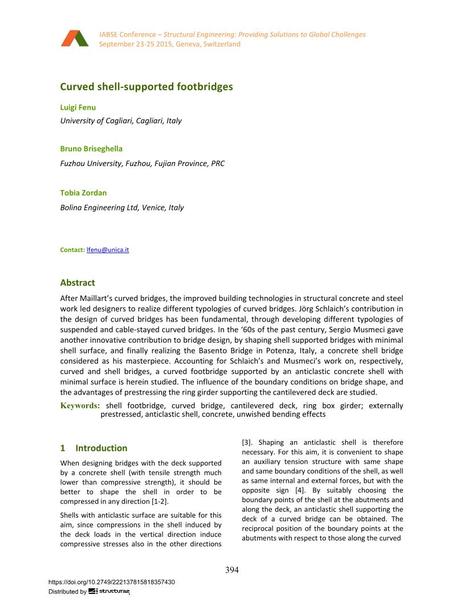Curved shell-supported footbridges

|
|
|||||||||||
Bibliographic Details
| Author(s): |
Luigi Fenu
(University of Cagliari, Cagliari, Italy)
Bruno Briseghella Tobia Zordan (Bolina Engineering Ltd, Venice, Italy) |
||||
|---|---|---|---|---|---|
| Medium: | conference paper | ||||
| Language(s): | English | ||||
| Conference: | IABSE Conference: Structural Engineering: Providing Solutions to Global Challenges, Geneva, Switzerland, September 2015 | ||||
| Published in: | IABSE Conference Geneva 2015 | ||||
|
|||||
| Page(s): | 394-401 | ||||
| Total no. of pages: | 8 | ||||
| Year: | 2015 | ||||
| DOI: | 10.2749/222137815818357430 | ||||
| Abstract: |
After Maillart’s curved bridges, the improved building technologies in structural concrete and steel work led designers to realize different typologies of curved bridges. Jörg Schlaich’s contribution in the design of curved bridges has been fundamental, through developing different typologies of suspended and cable-stayed curved bridges. In the ‘60s of the past century, Sergio Musmeci gave another innovative contribution to bridge design, by shaping shell supported bridges with minimal shell surface, and finally realizing the Basento Bridge in Potenza, Italy, a concrete shell bridge considered as his masterpiece. Accounting for Schlaich’s and Musmeci’s work on, respectively, curved and shell bridges, a curved footbridge supported by an anticlastic concrete shell with minimal surface is herein studied. The influence of the boundary conditions on bridge shape, and the advantages of prestressing the ring girder supporting the cantilevered deck are studied. |
||||
| Keywords: |
concrete Curved Bridge shell footbridge cantilevered deck ring box girder externally prestressed anticlastic shell unwished bending effects
|
||||


